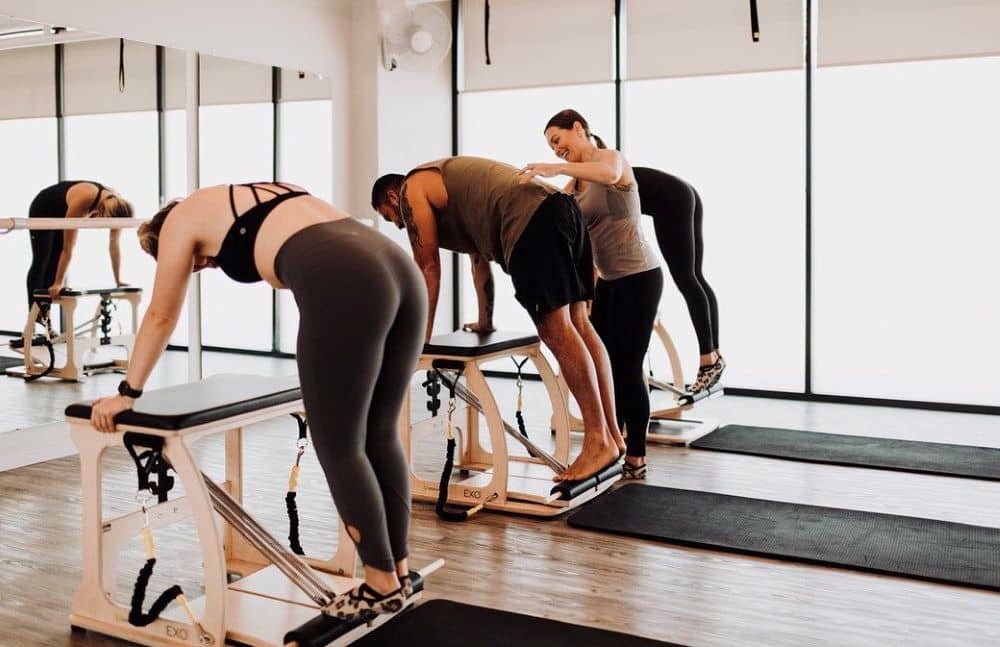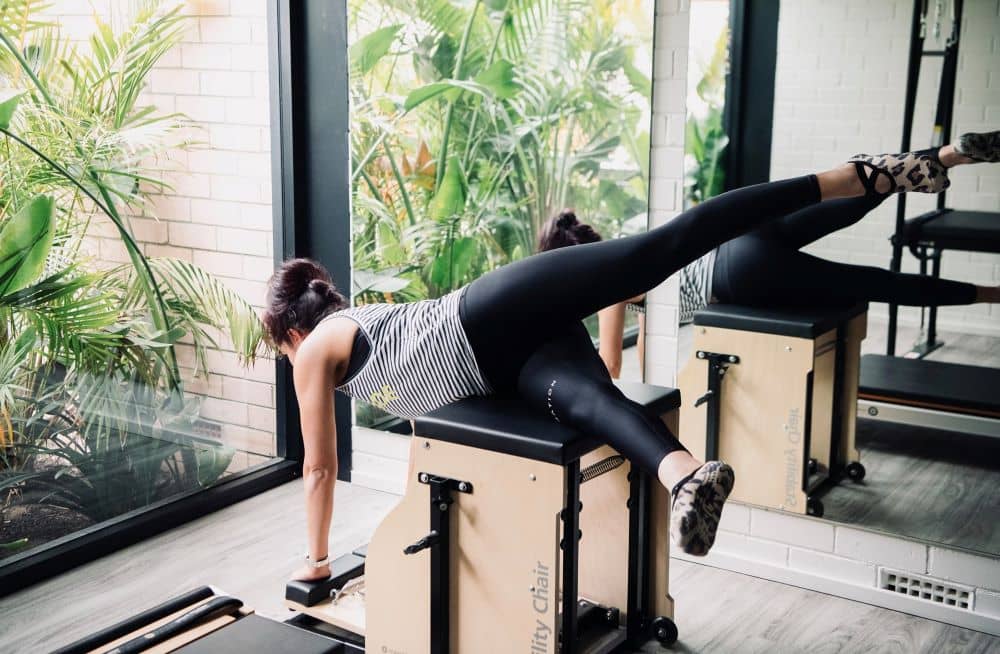Here, we’ll cover everything you need to know about the Pilates Chair and the benefits of Chair Pilates to decide if it’s the right class for you.
What Is a Pilates Chair?
The Pilates Chair is one of the original pieces of equipment engineered by Joseph Pilates, the founder of the practice.
The main parts of the Pilates chair include:
- The chair, typically a box constructed of wood
- A padded seat
- A pedal attached by springs (these springs control the amount of tension, allowing users to customise how difficult it is to perform a move)
- Two detachable handles on either side of the chair
How Does a Pilates Chair Work?
Chair Pilates tones the entire body from head to toe and improves balance by challenging the muscles with bodyweight, coordination, and spring resistance. The chair is an excellent piece of equipment for both seated and standing work.
What Are the Benefits of the Pilates Chair?
Incorporating a Pilates Chair into your workout is an effective way to challenge your body in new ways and keep your fitness routine fresh and exciting. The benefits of Chair Pilates include:
- Allows for greater versatility and creativity than some of the other Pilates machines
- Can be used from a seated position with the pedal behind you or in front of the pedal
- Excellent when used for injury rehab
- Its compact size makes it great for small studios or individuals with limited space to work out in their home
- Great for individuals who are new to Pilates and want to keep progressing
- Wonderful tool for advanced practitioners looking to add a new level of difficulty to their workouts (for example, if you’ve mastered footwork on the reformer, you can perform a more advanced version of it by standing and using the chair’s pedals or you can perform push-ups using the chair’s handles)
- Easily customisable — resistance can be adjusted according to the user’s current fitness level or the handles can be adjusted to be more supportive for beginners or individuals with an injury
- Can be used in conjunction with other pieces of Pilates equipment to make certain moves more attainable (i.e. pushed up to a trapeze table)
- Can help enhance sports performance due to its ability to build arm and leg strength effectively, improve mobility and balance, enhance flexibility, and strengthen the upper body
- Can be used for fun, interesting, challenging acrobatic movements to keep your workouts exciting and enjoyable
Tips on What to Look in a Pilates Chair for Home or Studio Use
If you are wondering ‘What is the best Pilates Chair?’ for your home or studio, here are some features to pay attention to so you can find the chair that is best suited to your needs and current fitness level.
Here are tips on choosing the best Pilates chair to use at home:
- Split Pedal or Single Pedal — Decide if you want a one-piece pedal or a split pedal (a split pedal allows for greater versatility and allows for movements with rotation)
- Seat Height — If you are especially short or tall, it is important to pay attention to the height of your Pilates chair and make sure it comfortably accommodates your frame.
- Handles — Consider buying a Pilates Chair with handles if you need help balancing, are older or recovering from an injury, or are looking to clean up your technique and fine-tune your movements.
- Seat Sizing — You’ll find most chairs are suitable and comfortable for a range of sizes, but some Pilates Chairs run quite small. Make sure to avoid a chair with an abnormally small seat and choose one that is comfortable for your body.
- Padding — For the ultimate in comfort, select a Pilates Chair with padding.
- Location and Usage — Are you going to move your Pilates chair to a storage closet or off to the side every time you are done using it? If so, you’ll want a chair that is lightweight and easy for you to move around (some chairs even come with wheels for excellent portability).
Along with choosing the best Pilates chair based on functionality, you may want to pay attention to the appearance as well. You can find chairs with a modern metal look, a timeless wood appearance, custom colours or upholstery, and other aesthetic features to meet your preferences.
Is Chair Pilates Right for Me?
Do you love Mat Pilates and Reformer Pilates? Consider Chair Pilates a perfect mashup of the best traits of these two classes. We welcome all levels to join us for this dynamic, energising workout.
Tips for Your First Chair Pilates Class
While the Pilates Chair can be one of the most challenging pieces of Pilates equipment, Chair Pilates is also an ideal class for beginners.
Here are some tips for your first Chair Pilates class:
- Always wait for instruction on using the chair
- Take your time as you perform each move and get to know the chair
- Pay attention to your breath
- Engage your core during movements
- Listen to your body — moves should feel challenging but never painful
- If you are unsure of the proper technique for a move, need a modification, or have a question about using the chair, ask for help
- Follow modifications as needed
- Keep your movements precise, deliberate, and controlled
- Have fun and keep trying!
For more tips for your first Pilates class, read our Guide to Your First Pilates Class.
Are You Interested in Trying Chair Pilates?
If you are looking to switch up your workout routine, rebuild strength after an injury, or improve your balance, Chair Pilates is an excellent class to consider.
If you have more questions about Chair Pilates or would like to join us for a class, we’d love to talk to you. Feel free to contact us anytime or book a class with us using our convenient online scheduler.


